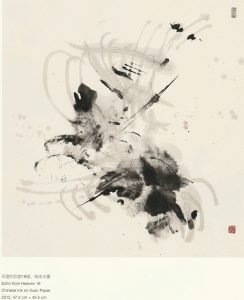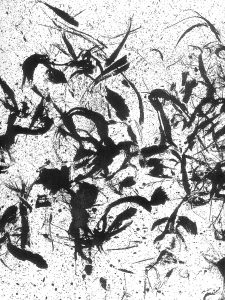Dawo, when words become images again, the great challenge of contemporary abstract calligraphy
Simone Schuiten et Xiaoman Li
When words become images again, the great challenge of contemporary abstract calligraphy


Dawo was born in 1942, a scholar family with profound China’s cultural knowledge and academic background since his grandparents’ generation. His grandfather was a professor in Peking University, where his mother also studied and contributed to. His father taught Western literature in an international relations and diplomacy institute in Tianjin, and he was very fond of collecting art and photographs. Dawo mostly lived in Beijing before 1992, then he moved to Tasmania, Australia till now. There is no doubt that Dawo thus brought up in a very traditional form and developed himself within the single cultural enlightenment for the first 40 years. Given birth in the new China era, Dawo obtained the access to Western culture not only from his family environment but also from the new and open cultural atmosphere in China, where he got inspired by Japanese calligraphy in the late 1970s. When considering his contemporary abstract calligraphy since 1982, it is therefore worth noting that his experiment of modern calligraphy provides a forceful expression of freedom and multiculture, as well as the reflection of Chinese water and ink calligraphy. The idea of “abstract” and “Chinese abstract” here, therefore relates to both spiritual and practical factors derived from the tradition, involves the discussion of concepts, tools, materials and mediums.
Dawo’s art is about researching the Dao of the writing. “Da wo”, in mandarin, translates as big, great (da) and me (wo). As a Daoist he strives to go beyond his individual little self to reach the great cosmic self. Building on this temperament, the writing of the “great multiple self” pursues the vital energy which feeds all things and which nature contains in itself. Dawo’s writing makes us sensitive to the art of the line, the stakes of which go beyond the decoding of ideograms.
From the beginning of the 1980s, the period in which the encounter between Chinese and Western aesthetics became possible, Dawo emancipates himself by letting his brush “flying”. He seeks to introduce a new breath into calligraphy and let the art of the line develop beyond the control of tradition. While he remains aware that abandoning the characters of a thousand-year-old script proves perilous, he strives to confront their capacity and their power. What he calls “flying off from paper” is a gestural process that will guide us to understand the emergence of contemporary abstract writing within Chinese aesthetics. We will also take into account its contribution and influence within Western culture.
Dawo does not reject the foundations of traditional calligraphy; quite the contrary, he is inspired by his roots which he has assimilated and integrated. He wishes to give them a more contemporary existence by detaching them or diverting them from the role of legibility which has been assigned to them. Separated from the obligations of direct communication, the lines making up the characters become line signs and the resulting writing is seen and even heard as line art.
For Dawo, Chinese calligraphy must transform as well as develop its openness and its participation in the vitality of nature. It is not a matter of imitating nature but rather of tapping into this reservoir of energy present in the cosmic flow and the flow of life. The open writing that Dawo offers us must continue to evolve, to transform. It exists in the movement which liberates it from all academic constraints. Because it refers to the primordial traits recorded by nature, it contains something wild, even chaotic.
Dawo refuses to be influenced and controlled by his own tradition, but he does not accept being subjected to the criteria of Western aesthetics either. Nevertheless, similarities and convergences between the two cultures appear as soon as one is interested in the question of abstraction. Abstraction is generally defined as the appearance of a line or an element which has been detached from the whole to which it belonged. This separation takes place through thought that interrupts immediate contact with the world only to retain the essentials of what has been understood. What remains through the process of abstraction belongs to an idea that concentrates the power of thought. Through art, a return to the sensible takes place, leading to a new negotiation with space. Between the material support and the power of the gesture an encounter between the interiority of the artist and the otherness of the world takes place. Abstract art opens up a space where the inner thrust of something can be expressed. On a surface, spatially, the exchange between the fully receptive spirit of the artist and the world in its intimate force, which Kandinsky calls inner sound, is inscribed.
This quest, based on the search for the interiority of the thing encountered, is particularly active in Dawo’s work. Interested in the flexibility of the lines he sees in nature, he tries to make his strokes as moving as possible. The mysterious sounds of the cosmos, the original rhythms and movements as well as the vibration of the world indicate the path to follow.
By means of ink and the “empty” wrist (1), Dawo manages to trace paths linking man to cosmic dynamics.
The artist proposes writing without direct readability which allows the lines to lead into the “open”. This attempt is an enormous challenge: he needs, in a contemporary practice free from the academic and bureaucratic constraints, to liberate the lines of strength and the genius of Chinese writing. Dawo is not an imperial official or a literate scholar. As an artist, he wants to be independent and open. Letting his hand dance on paper, he creates lines of a universal language. They invite us to celebrate and share in the vitality of nature. The use of ink reminds us through the brush stroke that we are always connected to the world. Despite our independence, the need for freedom and the use of abstraction, we remain imbedded into a vital process that Dawo makes apparent in each drawn line.
It is therefore a matter of keeping in touch with the most “naturating” element of nature, namely the lines of texture. Dawo indulges in the flexibility of the natural lines he sees in the foliage, the grass, the swirling of the wind, or even in the whirling of the clouds, the atmospheric turbulence, the agitation of the sky. All these lines show they are breathing and diffusing universal energy.
Because Dawo’s abstract lines contain a vital impulse, they emit a musical rustle that remains unresolved. In the same stride of the empty wrist, a rhythmic dance is initiated, giving rise to a constant expansion of the line.
The question of abstraction in Dawo’s calligraphy brings us back to the problem of our research on interculturality. Despite the differences between the Chinese and Western cultures, we have a common ground. On both sides, there is no longer any copying, imitating or representing reality faithfully. The artist’s quest is to look elsewhere or below the world’s first appearance. Let us refer to Kandinsky who proposes to understand the abstract line in the following way: A line which does not delimit anything, which no longer surrounds any outline, which no longer goes from one point to another, but passes between the points… ,without outside or inside, without form or background, without beginning or end, alive as a continuous variation.
In order to move on to abstract lines, and to restore the otherness of the characters and their basic strokes, Dawo first needed the courage to break free from the imperatives of classical writing. By abandoning direct communication as well as representations of reality frozen by conventions, he renounces figures and seeks for the inner necessity of natural phenomena. Brought back to life, to their original energy, the strokes move like lines which connect man to the cosmic rhythm.
Refusing to consider writing as a technology, Dawo composes a work made of vibrant, breathable, almost resonating atmospheric strokes. His writing-trace thus remains in the open, the characteristics reduced to their greatest simplicity lead us to an undifferentiated background with which the artist establishes empty-full exchanges.
The void summoned by the gesture freed from all convention makes tensions between the lines possible. Dawo’s abstract traces bear witness to the abundance of life, they connect – physically, spiritually, musically – the man who contemplates them to the world in which he is immersed. His indecipherable writing which has absorbed the vitality of existence makes us receptive to the dynamism of the connections between heaven and earth, nature and culture.
This new development in for the art of the line is also found in the West, in the research of Henri Michaux (1899-1984). During our interviews and his exhibition at ODRADEK, Dawo broadened his affinities with this French writer-painter of Belgian origin. Michaux, 40 years older than Dawo, was passionate about Chinese and Japanese gestural painting. He stayed in China in 1930 and 1931. We can establish cultural ties between the two artists. Without ever having physically met, they benefited from the culture of the other each in his own way. Both, from their own background and history, converge in the way they transform the word or character into an image. With them, writing returns to its origin, its constitutive breath appearing in images. Dawo and Michaux, by separate paths, arrive at the same result: they combine drawing and writing, painting and writing. For them, drawing remains the inalienable vehicle of our most authentic relationship to the world.
Their works, liberated from direct legibility, are a visual and sensitive approach to space. The surface on which the gesture is expressed speaks to us, as much as the signs traced on it. As such, the void allows the full to appear without being permanently fixed. The work remains ‘in progress’, it remains favorable to the dynamic tensions of the active lines on a surface. The space remains alive since it helps to free the stroke instead of forcing legibility upon them.
Michaux and Dawo remind us that before we can communicate reasonably, we need to open up, that is, to be sensitive and receptive to the correspondence of traces with a surface without wanting to identify them immediately. The traces displayed on a screen escape the surveillance of the academic and expert eye. They invite us to leave the known, readable and ready-to-use world and enter that of otherness and uninterrupted movement. This screen-surface allows life to continue, to cross and weave in multiple directions.
Michaux and Dawo are therefore artists operating out of the vital movement returned to existence. They embody an intentionality; they give access to their ever-changing interiority which their brush strokes reveal. That’s why we can consider them as philosophers-artists active on the scene of contemporary abstraction.
From readable to invisible, they guide our gaze allowing us to lose ourselves, to try and find ourselves in the fusion of their lines. These appear and disappear in splashes of ink or in imaginary alphabets or in improbable signs. The two artists take us away from the comfort of a well-ordered life. They lead us into the jumble of being and the emergence of the possible. With them we enter into a logic of loss so dear to Georges Bataille. Instead of accumulating reasonable wealth, they prefer to venture into spaces of dissolution, dilation and impermanence. Their traces neither affirm nor impose stable meanings. They intertwine the strokes that give them life. Mobility is their strength; both are focused on the void. Both remain open to the invisible drive of the rhythm of existence.
[1] The empty wrist is a Chinese expression that emphasizes the link uniting the artist with nature, that is the link that helps the artist to participate in the becoming of nature. The movement of the painter is an act of communion with nature and its vital organisation.